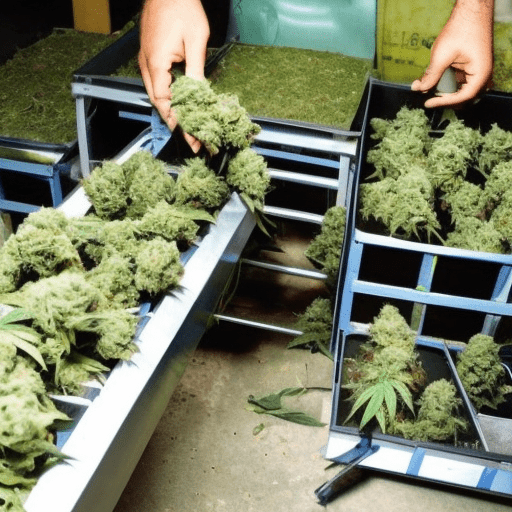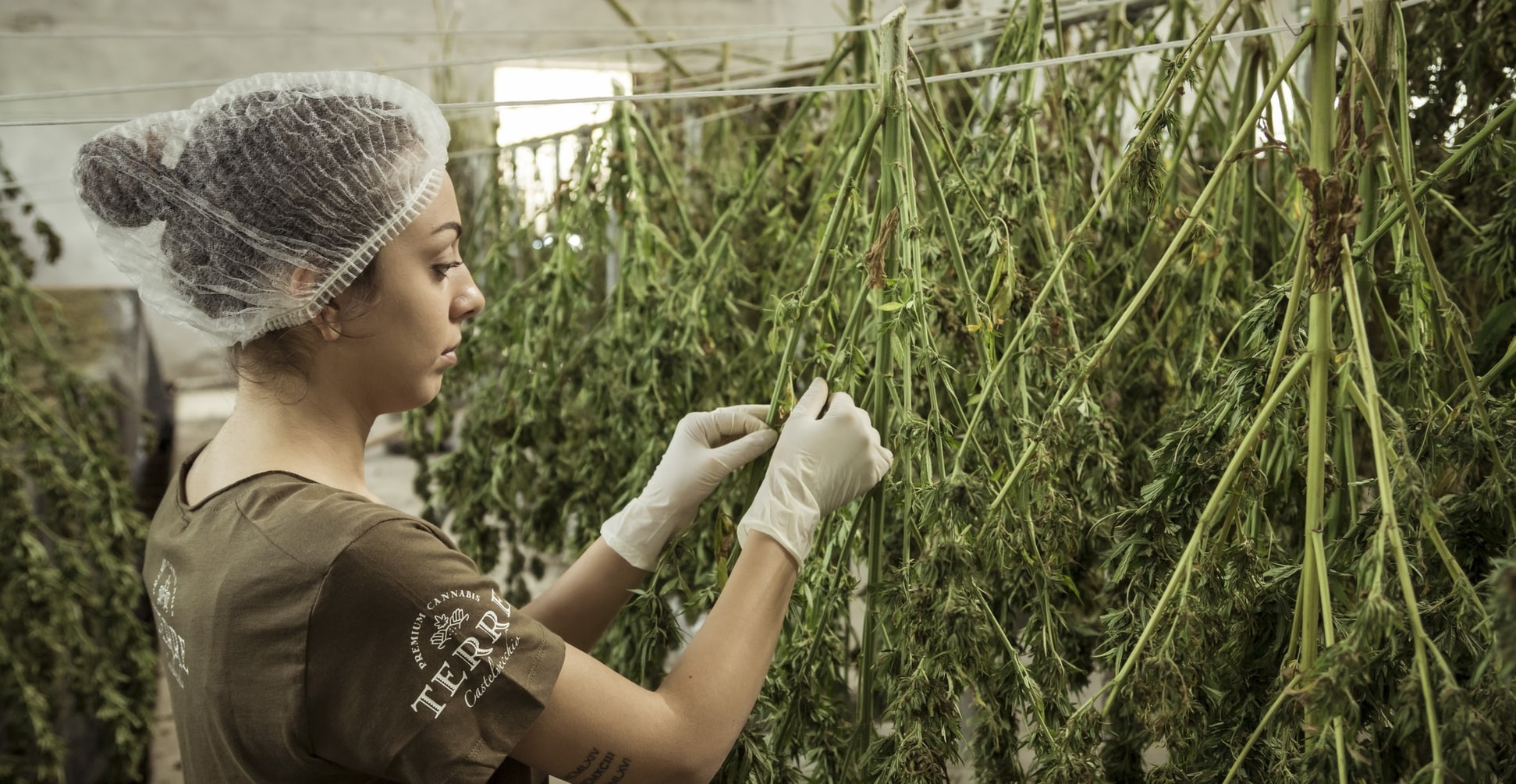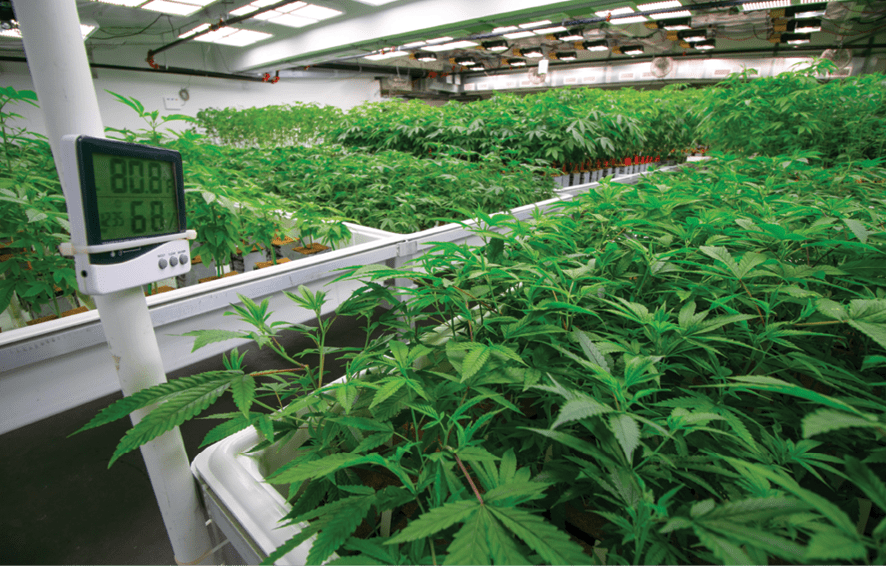Understand How to Create a Cannabis Business Plan & Follow Along As We Create a Real-Life Example for Each Section in the Plan
Are you interested in getting into the cannabis business? Well, you’re in luck because today we’re going to dive deep into the world of the cannabis business plan. A well-crafted cannabis business plan can be the key to success in this rapidly growing industry, and in this blog post, we’ll show you exactly how to create one.
The Different Types of ‘Plant Touching’ Cannabis Businesses
The cannabis industry is experiencing a remarkable evolution, as it becomes increasingly sophisticated and diverse. Gone are the days when the industry solely revolved around cultivation and dispensaries. Now, there are many different types of ‘plant-touching’ cannabis businesses that work in coordination with one another to create a seamless supply chain. These businesses include cultivation, laboratory testing, manufacturing, distribution, and dispensaries. We’ll give you a quick overview of each of these types of businesses, and an idea of how these businesses overlap.
Cannabis Cultivation Businesses
Cultivation is the backbone of the cannabis industry. It involves the cultivation and harvesting of cannabis plants, ensuring they are healthy and of high quality.
Cannabis Laboratory Testing Businesses
Once the plants are grown and harvested, they undergo laboratory testing. This step is crucial as it ensures the safety and compliance of the products, testing for various factors such as potency, contaminants, and microbial activity.

Cannabis Manufacturing Businesses
After laboratory testing, the cannabis products move on to the manufacturing phase. Here, various products are created, including extracts, concentrates, edibles, topicals, and more. The manufacturing process involves extracting cannabinoids from the plant material and formulating them into different products. This requires expertise and precision to ensure consistent quality and potency.
Cannabis Distribution Businesses
Once the manufacturing is complete, the products are ready for distribution. This involves transporting the cannabis products to dispensaries or other retail outlets. Distribution plays a crucial role in ensuring that the products reach the end consumers efficiently and safely. It requires compliance with regulations and secure transportation methods to maintain product integrity.
Cannabis Dispensary Businesses
Finally, the products reach the dispensaries, where consumers can purchase them. Dispensaries provide a range of cannabis products to meet the needs of different consumers. They offer a variety of strains, products, and consumption methods, ensuring that there is something for everyone. Dispensaries also play a vital role in educating consumers about the different products and their effects.
Vertically Integrated Cannabis Businesses
While these different businesses traditionally operated independently, some companies have chosen to take a vertical approach, handling every aspect of the supply chain from cultivation through to dispensary. This vertical integration allows companies to have greater control over the quality and consistency of their products and streamline operations.
Cresco Labs
One example of a vertical cannabis business is Cresco Labs. They operate cultivation centers, manufacturing facilities, and dispensaries, ensuring a seamless supply chain from seed to sale. By controlling every step of the process, they can maintain high standards and provide consumers with a wide range of products.

MadMenb
Another example is vertically integrated cannabis company MedMen. They have cultivation facilities, manufacturing operations, and a chain of dispensaries across multiple states. This approach allows them to maintain consistency in their products and provide a seamless customer experience from cultivation to the retail environment.
Vertical integration in the cannabis industry is not limited to large companies. Many smaller companies have also adopted this approach, recognizing the benefits it offers in terms of quality control and efficiency.
Related Reading
Building Blocks for Creating an Effective Business Plan
Effective business planning is crucial for the success of any cannabis business. It involves several building blocks that need to be carefully considered and executed. These building blocks include figuring out a financing strategy, creating a business plan, and developing an executive summary.
Financing Strategy
The first step in effective business planning for a cannabis business is figuring out a financing strategy. This involves determining how much capital is needed to start and operate the business, as well as identifying potential sources of funding. This could include self-funding, loans from banks or investors, crowdfunding, or partnerships. It is important to thoroughly research and analyze the financial requirements of the business to ensure that the financing strategy aligns with the specific needs and goals of the cannabis business.
Business Strategy Planning
Once the financing strategy is in place, the next step is to create a comprehensive business plan. A business plan serves as a roadmap for the future of the cannabis business and provides a detailed understanding of its operations, market analysis, products or services, marketing strategies, and financial projections. It should also include information on the legal and regulatory environment surrounding the cannabis industry, as well as any unique challenges or opportunities that the business may face.
Financing Options for Cannabis Businesses
The cannabis industry has been steadily gaining traction in the financial world, with an increasing number of financing options becoming available. One of the ways cannabis companies can secure funding is through equity raises, where they sell a portion of their ownership in exchange for capital. This has been a popular method of raising funds in the North American cannabis capital raise environment.
According to a report by EY and Viridian, the divide between equity raises and debt raises has shifted over the years. Here’s a table showcasing how the financing method is tilting more towards debt-financing in recent years.
| Year | Debt Funds Raised (%) | Equity Funds Raised (%) |
|---|---|---|
| 2018 | 18.2 | 81.8 |
| 2019 | 28.6 | 71.4 |
| 2020 | 62.4 | 37.6 |
| 2021 | 43.5 | 56.5 |
| 2022 | 41.1 | 58.9 |
Venture Capital Financing for Cannabis Businesses
That being said, Venture capital (VC) funding has also become a significant avenue for cannabis companies to tap into. The rapid growth of the industry has attracted VC investment, with approximately $5.3 billion deployed into 544 cannabis-related companies globally since 2014. The projection for the global cannabis market is expected to reach nearly $100 billion by 2026, with a compound annual growth rate (CAGR) of 28%. This promising outlook has caught the attention of venture capitalists looking to capitalize on this burgeoning industry.

Debt Financing for Cannabis Businesses
On the other hand, debt financing has emerged as a primary source of growth capital for cannabis companies. As the industry matures, lenders are drawn to the underlying real estate collateral and visible cash flows of well-performing companies. This is especially true in light of falling equity prices. While equity financing has traditionally been the go-to option for growth-oriented investors, the availability of debt financing provides an alternative path to accessing capital for cannabis companies.
How to Write Your Cannabis Business Plan: Executive Summary
The executive summary is a crucial part of a cannabis business plan as it provides a concise overview of the entire plan. From the perspective of a cannabis cultivator/producer, the executive summary serves as a snapshot of the company’s vision, goals, and potential. It captures the attention of potential investors, lenders, or partners, enticing them to delve deeper into the business plan.
Now, let’s take a closer look at the sections that should be included in the executive summary:
1. Business Information
This section provides a brief introduction to the company, including its legal entity, location, and a concise description of the business model. It should highlight key points such as the company’s mission, values, and unique selling proposition (USP). Additionally, it may touch upon the company’s history, milestones, and any notable partnerships or collaborations.
2. Products and Services
Here, the executive summary outlines the specific products and/or services that the cannabis cultivation business offers. It should emphasize the quality and uniqueness of the products, such as strains, cultivation techniques, or proprietary processes. This section can also mention any ancillary products or services that complement the main offering, such as distribution or retail partnerships.
3. Target Market & Buyer Persona
The executive summary should provide an overview of the target market for the cannabis products. This includes demographic information, consumer behavior, and market size. Additionally, it should highlight the buyer persona, describing the ideal customer and their preferences. This section may also touch upon market trends and opportunities within the cannabis industry.

4. Competitors
In this section, the executive summary identifies and analyzes key competitors in the cannabis cultivation space. It should provide a brief overview of the competitive landscape, highlighting the company’s unique advantages over its competitors. This can include factors such as product differentiation, pricing strategies, market positioning, or strategic partnerships.
5. Team Members
The executive summary briefly introduces the key members of the management team, highlighting their relevant experience, skills, and qualifications. It should showcase the team’s expertise in cannabis cultivation, business management, compliance, and any other relevant areas. This section may also mention any strategic advisors or consultants that contribute to the company’s success.
6. Financial Summary
Lastly, the executive summary provides a high-level overview of the company’s financial projections and needs. It should include key financial metrics such as revenue forecasts, projected profitability, and capital requirements. This section can also mention any existing funding or investment secured, as well as the company’s strategy for future financial growth.
Example of an Executive Summary for a Cannabis Business
Now, let’s take a look at an example of an executive summary for a mid-sized cannabis cultivation business:
Business Information
Our company, Green Leaf Cultivation, is a mid-sized cannabis cultivator based in San Francisco, California. We are a legal entity operating in compliance with all state and local regulations. With a deep passion for cannabis and a commitment to sustainable cultivation practices, our mission is to provide high-quality, organically-grown cannabis products to the market.
Products and Services
Green Leaf Cultivation offers a diverse range of premium cannabis strains, carefully selected for their potency, aroma, and medicinal properties. Our cultivation techniques prioritize environmental sustainability, utilizing organic soil, natural fertilizers, and innovative water-saving techniques. In addition to our flower products, we also offer pre-rolls and concentrates to cater to the varying preferences of our customers.
Target Market & Buyer Persona
Our target market consists of both medical and recreational cannabis consumers aged 21 and above. We primarily focus on health-conscious individuals who seek natural alternatives and value the therapeutic benefits of cannabis. Our buyer persona is an educated professional who appreciates premium products, values sustainability, and seeks transparent sourcing and testing information.
Competitors
In the highly competitive cannabis industry, we differentiate ourselves through our commitment to sustainable cultivation practices and our focus on high-quality products. While there are several established competitors in the market, our unique strain selection, organically-grown approach, and dedication to customer satisfaction set us apart. We continuously monitor the market and adapt our offerings to stay ahead of emerging trends.
Team Members
Green Leaf Cultivation boasts a highly experienced and passionate management team. Our CEO, John Green, brings over a decade of experience in the cannabis industry, with a deep understanding of cultivation techniques and market dynamics. Our team also includes a master grower, compliance officer, and marketing specialist, each with extensive knowledge in their respective fields.
Financial Summary
With a projected annual revenue of $5 million in the first year of operation, Green Leaf Cultivation anticipates strong growth as we expand our cultivation capacity. We are seeking a total investment of $2 million to fund facility expansion, marketing efforts, and operational costs. We have already secured $500,000 in funding through private investment, demonstrating investor confidence in our business model and growth potential.
How to Write Your Cannabis Business Plan: Industry Analysis
When crafting a cannabis business plan, an industry analysis section plays a critical role in providing valuable insights to support the success of a cannabis cultivator/producer. This section helps to establish a solid foundation by thoroughly examining the market environment, understanding competitors, identifying key trends, and evaluating opportunities and threats. Let’s delve into the essential components that should be included in this industry analysis section.
1. Market Size
The market size section provides an overview of the total addressable market for cannabis cultivation. It includes data on the current and potential customer base in terms of demographics, geographic distribution, and market segmentation. For example, it would highlight the size of the medical and recreational cannabis markets, both locally and globally, along with any regulatory restrictions that may impact the cultivation business.
2. Market Growth Rate
This section focuses on analyzing the growth potential of the cannabis market. It involves researching and presenting data on the historical, current, and projected growth rates of the market. This data can be sourced from industry reports, market research firms, and government publications. For instance, it may highlight the compound annual growth rate (CAGR) of the cannabis industry and specific factors driving that growth.

3. Competitors Analysis
A thorough competitor analysis is crucial to understanding the competitive landscape and developing effective strategies. This section should identify and evaluate direct and indirect competitors in the cannabis cultivation sector. It should delve into their market share, product offerings, pricing strategies, distribution channels, strengths, and weaknesses. Additionally, including information about their cultivation techniques, strains, and branding strategies would be beneficial.
4. SWOT Analysis
The SWOT (Strengths, Weaknesses, Opportunities, and Threats) analysis section helps to evaluate internal and external factors impacting the business. It assesses the strengths and weaknesses of the cannabis cultivation business, such as the expertise of the team, growing techniques, access to capital, and potential challenges like regulatory restrictions and limited market access. Moreover, it identifies opportunities and threats arising from market trends, consumer preferences, and competition.
5. Key Trends/Themes
This section highlights the emerging trends and themes in the cannabis industry that impact the cultivation business. It may involve discussing the shift from the black market to the regulated market, changing consumer preferences, technological advancements, and the influence of sustainability and organic practices. Additionally, incorporating information about evolving regulations, social acceptance, and market dynamics is crucial for staying ahead in the industry.
6. Other Important Components
Apart from the sections mentioned above, it is essential to include additional components to ensure a comprehensive industry analysis. These may include:
- Regulatory Environment: Understanding the legal framework and compliance requirements specific to the cannabis cultivation business.
- Distribution Channels: Analyzing the different distribution channels available for reaching the target market, such as dispensaries, online platforms, and partnerships.
- Consumer Behavior: Examining consumer preferences, purchasing patterns, and attitudes towards cannabis products.
- Supply Chain Analysis: Assessing the key suppliers, vendors, and partners involved in the cultivation process.
- Pricing Strategies: Evaluating pricing models and strategies adopted by competitors in the market.
- Market Entry Barriers: Identifying any obstacles or challenges related to the entry into the cannabis cultivation market.
Example of an Industry Analysis Section
Market Size:
The global cannabis market is estimated to reach $73.6 billion by 2027, with the medical cannabis segment accounting for $55.8 billion of the market share. The U.S. cannabis market alone is projected to reach $41 billion by 2025, driven by the increasing legalization of recreational and medical cannabis across various states. The cultivation business will primarily target consumers aged 25-44, who constitute the largest demographic segment interested in cannabis products.
Market Growth Rate
The cannabis industry has experienced rapid growth in recent years, with a CAGR of 26.7% from 2019 to 2027. The market is expected to witness continued expansion due to increasing acceptance, evolving regulatory frameworks, and growing consumer demand. Moreover, the acceleration of international legalization efforts and the potential for new markets opening up contribute to the projected growth rate.
Competitors Analysis
The primary competitors in the cannabis cultivation space include ABC Cultivators, XYZ Farms, and Green Leaf Enterprises. ABC Cultivators holds a significant market share due to their established distribution network and premium strains. XYZ Farms differentiates itself through sustainable cultivation practices, while Green Leaf Enterprises focuses on high-quality organic strains. Understanding their strengths and weaknesses will help us position our business effectively.
SWOT Analysis
Strengths:
- Experienced cultivation team with expertise in organic farming practices.
- Access to a secure and scalable cultivation facility.
- Strong relationships with local dispensaries and potential partners.
Weaknesses:
- Limited brand recognition compared to established competitors.
- Reliance on external suppliers for certain cultivation inputs.
- Need for additional funding for expansion and technology investments.
Opportunities:
- Growing consumer interest in organic and sustainable cannabis products.
- Potential for international expansion in emerging markets.
- Collaboration opportunities with research institutions for strain development.
Threats:
- Regulatory changes impacting cultivation practices.
- Intense competition from established and new entrants.
- Supply chain disruptions due to unforeseen factors.
Key Trends/Themes
- Increasing adoption of cannabis for medicinal purposes.
- Shifting consumer preferences towards premium and organic strains.
- Technological advancements in cultivation techniques, automation, and data analytics.
- Growing acceptance and changes in regulations related to cannabis.
This example demonstrates how each component of the industry analysis section can be addressed in a cannabis cultivation business plan. By conducting a comprehensive analysis, businesses can gain valuable insights to inform their strategic decisions, identify competitive advantages, and navigate the dynamic cannabis industry successfully.
How to Write Your Cannabis Business Plan: Company Analysis
A company analysis section serves as a crucial component of a cannabis business plan, especially from the perspective of a cultivator or producer. This section provides a comprehensive overview of the market, identifying the target audience, the size of the market, and the company’s potential share within that market. By conducting a thorough analysis, cannabis cultivators can better understand their position and develop strategies to maximize their profitability and success.
The company analysis section typically consists of three key components: segmented available market (SAM), total available market (TAM), and share of the market (SOM). Let’s delve into each section and explore what should be included:
1. Segmented Available Market (SAM)
In this section, the cannabis cultivator identifies and defines the specific segments of the market they intend to target. This involves segmenting the market based on various factors, such as demographics, geographic location, consumer behaviour, and product preferences. For instance, segments could include medical cannabis users, recreational consumers, or specific demographic groups such as seniors or millennials. The SAM section should provide a detailed overview of each segment, including their size, growth potential, and any unique characteristics that may impact the company’s approach
2. Total Available Market (TAM):
The TAM section outlines the total size and value of the market the cannabis cultivator intends to operate in. This involves conducting market research and analysis to estimate the overall demand for cannabis products within the defined market. The TAM should consider factors such as population size, consumption patterns, regulatory framework, and any relevant trends or forecasts. By determining the TAM, the cannabis business can assess the market’s potential and identify opportunities for growth.

The SOM section focuses on defining the company’s targeted market share within the overall market. This involves estimating the percentage of the TAM that the cannabis cultivator aims to capture. To determine the SOM, one must consider factors such as competitive landscape, market saturation, and the company’s unique value proposition. It is essential to conduct a thorough analysis of the competition, assessing their strengths, weaknesses, and market presence. By understanding the SOM, the cannabis business can set realistic goals and develop strategies to gain a competitive advantage.
Now, let’s create an example of a company analysis section for a mid-sized cannabis cultivation business:
Example of a Company Analysis Section
Segmented Available Market (SAM):
Our mid-sized cannabis cultivation business aims to target two primary market segments: medical cannabis users and recreational consumers. The medical segment consists of patients seeking cannabis products for therapeutic purposes, while the recreational segment comprises individuals seeking cannabis for personal use and enjoyment. Both segments exhibit significant growth potential, with an increasing acceptance and adoption of cannabis across various demographics and geographic locations.
Total Available Market (TAM):
Based on extensive market research and analysis, we estimate that the total market size for cannabis in our target region is approximately $X billion annually. This estimate factors in population size, consumption patterns, and the local regulatory framework. Furthermore, with the recent legalization of recreational cannabis in our region, we expect the market to experience substantial growth in the coming years, presenting lucrative opportunities for our cultivation business.
Our goal is to capture an X% share of the total market within the first year of operation, gradually increasing to X% by the end of the third year. To achieve this, we have conducted a comprehensive analysis of our competition, identifying their strengths and weaknesses. By leveraging our expertise in sustainable cultivation practices, premium product offerings, and strong distribution partnerships, we believe we can differentiate ourselves and gain a competitive edge in the market. We will also invest in targeted marketing campaigns to raise awareness and establish our brand as a trusted and reliable source of high-quality cannabis products.
How to Write Your Cannabis Business Plan: Sales & Marketing Plan
The sales and marketing plan section of a cannabis business plan serves as a roadmap for how a cultivator/producer will position their brand, communicate their message, and implement key marketing tactics to drive sales and establish a strong market presence. This section is essential in demonstrating a comprehensive understanding of the target market, competitors, and the strategies needed to differentiate the business from others in the industry.
Let’s take a closer look at the components that should be included in this section:
1. Positioning:
In the positioning section, the cannabis cultivator/producer should clearly define the unique value proposition and target market segment they intend to serve. This involves understanding the needs, preferences, and behaviors of their target customers. The positioning statement should articulate how the business will differentiate itself from competitors regarding product quality, pricing strategy, cultivation techniques, sustainability practices, or any other factors that set it apart.
2. Messaging:
The messaging section outlines the key messages and brand story that will be conveyed to the target market. It should emphasize the business’s values, mission, and commitment to quality. The messaging should also highlight the benefits and unique selling points of the products, such as potency, strain variety, organic cultivation practices, or any other factors that resonate with the target market. Clear and concise messaging is crucial to establishing a strong brand identity and building customer trust.
3. Key Marketing Tactics:
This section outlines the specific marketing tactics that will be employed to reach and engage the target market. It should include a mix of online and offline strategies tailored to the unique needs and preferences of cannabis consumers. Some key marketing tactics could include:
- Digital Marketing: This may include website optimization, search engine optimization (SEO), content marketing, email marketing, social media advertising, influencer partnerships, and online community building.
- Advertising and PR: This may include traditional advertising channels such as print, radio, and television, as well as public relations efforts to generate media coverage, press releases, and participation in industry events and trade shows.
- Brand Partnerships: Collaborating with complementary brands or influential figures in the cannabis industry can help broaden the reach and credibility of the business. This could involve joint marketing campaigns, cross-promotions, or sponsorships.
- Product Packaging and Design: Thoughtful and visually appealing packaging design can help attract consumers and differentiate the brand on dispensary shelves. This section should outline the considerations for packaging design, such as sustainability, child-resistant features, and compliance with local regulations.

Now, let’s create an example sales and marketing section for a mid-sized cannabis cultivation business:
Example of a Sales & Marketing Plan Section
1. Positioning:
Our cannabis cultivation business aims to position itself as a premium producer of organic, sustainably grown cannabis products targeting health-conscious consumers seeking high-quality and responsibly sourced options. We will differentiate ourselves by incorporating regenerative farming practices, ensuring our products are pesticide-free, and offering a diverse range of strains to cater to the specific needs and preferences of our target market.
2. Messaging:
Our messaging will emphasize our commitment to quality, sustainability, and customer satisfaction. We will communicate our dedication to cultivating premium cannabis products using organic methods and highlight the benefits of our diverse strain selection. Our brand story will revolve around our passion for providing consumers with a safe and enjoyable cannabis experience while supporting eco-friendly farming practices.
3. Key Marketing Tactics:
- Digital Marketing: We will optimize our website for search engines and create valuable content, such as educational articles and strain reviews, to attract and engage our target market. We will also leverage social media platforms, partnering with cannabis influencers and running targeted advertising campaigns to raise awareness of our brand and products.
- Advertising and PR: We will invest in local print and radio ads to reach our target market effectively. Additionally, we will actively engage in public relations efforts, including press releases and media outreach, to generate positive coverage and establish our credibility in the industry.
- Brand Partnerships: We will seek partnerships with other health and wellness brands, such as organic food producers or fitness influencers, to expand our reach and tap into their existing customer bases. Collaborative marketing campaigns and cross-promotions will help us gain visibility and build trust within our target market.
- Product Packaging and Design: Our packaging will be designed with sustainability in mind, utilizing eco-friendly materials and incorporating child-resistant features. We will prioritize eye-catching designs that reflect our brand values and stand out on dispensary shelves, effectively attracting the attention of potential customers.
Related Reading
- Cannabis Business Consultants
- Seed To Sale CRM
- Cannabis Cultivation Business Plan
- Seed To Sale Funding
- Cannabis Dispensary Business Plan
- Cultivation SOP Template
- Cannabis Licensing Consultant
- Cannabis Venture Capital
- Grants For Cannabis Business
How to Write Your Cannabis Business Plan: Operations & Security Plan
The operations & security plan section of a cannabis business plan serves a crucial purpose in ensuring the smooth and safe operation of a cannabis cultivation/production business. This section outlines the measures and strategies that will be implemented to secure the products and facility, as well as the standard operating procedures (SOPs) and quality assurance/quality control (QA/QC) plan.
Security Plan
In the plan for securing products/facility section, it is important to detail the security measures that will be implemented to protect the cannabis products from theft, unauthorized access, and other risks. This may include physical security measures such as video surveillance systems, alarms, locks, and restricted access areas. Additionally, the plan should address the security of the facility itself, including measures to prevent break-ins, fire hazards, and other potential threats. It is also essential to include details about any security personnel or security companies that will be employed to ensure round-the-clock protection.
SOPs
The SOPs section outlines the step-by-step procedures and guidelines that will be followed for various operations within the cultivation/production process. This includes everything from germination and cultivation to harvesting, trimming, drying, and curing. Each SOP should be clear and detailed, providing information on the equipment, materials, and techniques to be used, as well as any safety precautions or quality standards to adhere to. It is important to emphasize the importance of consistency and compliance with SOPs in order to maintain product quality and regulatory compliance.

QA & QC Plan
The QA/QC plan section outlines the quality assurance and quality control measures that will be implemented to ensure that the final products meet the required standards of quality, purity, and potency. This may include regular testing of the cannabis products for potency, microbial contaminants, pesticides, and other impurities. The plan should also address the protocols for tracking and documenting test results, as well as any corrective actions that will be taken in case of non-compliance. It is crucial to emphasize the commitment to quality control and the importance of providing safe and effective products to consumers.

Did you know? GrowerIQ has an industry-leading Seed-to-Sale Cannabis Software (with quality management built in) that is designed to uncomplicate cannabis production for cannabis producers throughout the world.
Now, let’s take a look at an example of an operations and security plan section for a mid-sized cannabis cultivation business:
Example of an Operations & Security Plan
Securing Products/Facility
- Physical Security Measures:
- Installation of a comprehensive video surveillance system covering all areas of the facility, including entrances, exits, and cultivation areas.
- Implementation of alarm systems with 24/7 monitoring to detect any unauthorized access or suspicious activities.
- Use of secure locks and restricted access areas to limit entry to authorized personnel only.
- Regular assessment of the facility’s physical vulnerabilities and implementation of necessary upgrades or improvements.
- Security Personnel:
- Employment of licensed security guards who will be responsible for monitoring the facility and responding to any security threats or incidents.
- Development of a security personnel training program to ensure that all guards are well-equipped to handle potential security risks.
- Inventory Control:
- Implementation of a robust inventory management system to track the movement of cannabis products within the facility, from seed to sale.
- Adoption of barcoding or RFID technology to maintain accurate records of all products and prevent any loss or diversion.
Standard Operating Procedures (SOPs):
- Cultivation:
- Detailed guidelines on seed selection, germination, and cloning techniques.
- Step-by-step instructions on nutrient and water management, as well as pest and disease control.
- Harvesting protocols and procedures for maximizing yield and maintaining product quality.
- Processing and Extraction
- SOPs for drying, trimming, and curing of harvested cannabis plants.
- Extraction protocols for producing concentrates, oils, and other derivative products.
- Packaging and labeling guidelines to ensure compliance with regulatory requirements.
- Quality Assurance/Quality Control (QA/QC) Plan
- Product Testing:
- Regular testing of cannabis products for potency, microbial contaminants, residual solvents, and other impurities.
- Collaboration with accredited third-party laboratories for independent verification of test results.
- Documentation and Record-Keeping:
- Establishment of a comprehensive record-keeping system to document all QA/QC activities, including test results, batch numbers, and associated data.
- Periodic internal audits to ensure compliance with QA/QC procedures and identify areas for improvement.
- Product Testing:
- Corrective Actions:
- Development of protocols for addressing any non-compliance issues identified through testing or audits.
- Timely implementation of corrective actions to rectify any deviations from quality standards and prevent reoccurrence.
How to Write Your Cannabis Business Plan: Financial Plan
A financial plan section is an essential part of a cannabis business plan, especially from the perspective of a cannabis cultivator or producer. It serves the purpose of providing a comprehensive overview of the financial aspects of the business, including projections and potential risks. This section is crucial for potential investors and lenders who want to assess the feasibility and profitability of the venture.
The financial plan section typically includes three main components: balance sheets, cash flow statements, and income statements, including pro forma statements. Let’s dive into each of these components and what should be included in them:
1. Balance Sheets
A balance sheet provides a snapshot of the company’s financial position at a specific point in time. It includes assets, liabilities, and equity.
For a cannabis cultivation business, the balance sheet should include assets like land, buildings, equipment, and inventory. Liabilities may include loans, accounts payable, and any outstanding debts. Equity represents the owner’s investment and retained earnings. This section helps investors gauge the company’s liquidity and financial stability.
2. Cash Flow Statements
The cash flow statement shows the inflow and outflow of cash over a specific period. It includes three categories: operating activities, investing activities, and financing activities.
For a cannabis cultivation business, the cash flow statement should reflect revenue from the sale of cannabis, operating expenses such as labour, utilities, and raw materials, and any investments or loans acquired. This section provides insights into the company’s ability to generate cash and its overall financial health.
3. Income Statements
The income statement, also known as the profit and loss statement, summarizes the company’s revenues, expenses, and net income over a specific period. It helps assess the profitability of the business.
For a cannabis cultivation business, the income statement should include revenue from the sale of cannabis, cost of goods sold (including cultivation expenses, processing, and packaging costs), operating expenses (such as marketing, administrative, and rent), and taxes. This section demonstrates the company’s ability to generate profits.
4. Pro-Forma Statements
Pro-forma statements are future-oriented financial projections based on historical data and assumptions. They provide a forecast of the company’s financial performance, allowing investors and lenders to evaluate the potential return on investment. Pro-forma income statements should estimate future revenues, costs, and profits. Pro-forma cash flow statements project future cash inflows and outflows. Pro-forma balance sheets forecast the company’s financial position at a future date.
Now, let’s take a look at an example of a financial plan section for a mid-sized cannabis cultivation business:
Example of an Financial Plan Section
1. Balance Sheet
| Category | Item | Value |
|---|---|---|
| Assets | Land | $500,000 |
| Buildings | $1,200,000 | |
| Equipment | $300,000 | |
| Inventory | $100,000 | |
| Liabilities | Loans | $800,000 |
| Accounts Payable | $50,000 | |
| Equity | Owner’s Investment | $1,250,000 |
| Retained Earnings | $150,000 |
2. Cash Flow Statement
| Activity | Item | Value |
|---|---|---|
| Operating Activities | Revenue from Cannabis Sales | $2,000,000 |
| Operating Expenses | $1,500,000 | |
| Net Cash Flow | $500,000 | |
| Investing Activities | Equipment Purchase | $100,000 |
| Financing Activities | Loan Acquisition | $800,000 |
3. Income Statement
| Category | Item | Amount |
|---|---|---|
| Revenue | Cannabis Sales | $2,000,000 |
| Cost of Goods Sold | Cultivation Expenses | $600,000 |
| Processing and Packaging Costs | $200,000 | |
| Operating Expenses | Marketing | $100,000 |
| Administrative | $100,000 | |
| Rent | $50,000 | |
| Taxes | $120,000 | |
| Net Income | $930,000 |
Pro-Forma Statements
- Pro-Forma Income Statements: Projected revenue growth of 10% per year for the next five years, estimating net income of $1,200,000 in Year 1, $1,500,000 in Year 2, and so on.
- Pro-Forma Cash Flow Statements: Forecasted cash inflows and outflows based on projected revenue growth, operating expenses, and investments.
- Pro-Forma Balance Sheets: Projected assets, liabilities, and equity based on the expected growth and financial activities of the business.
How to Write Your Cannabis Business Plan: Technology Plan
The technology plan section of a cannabis business plan serves a crucial purpose for cannabis cultivators/producers. In this fast-paced and rapidly evolving industry, technology plays a vital role in ensuring efficient operations, maximizing productivity, and maintaining compliance with regulations. A well-thought-out technology plan can help cannabis businesses stay ahead of the curve and position themselves for long-term success.
Hardware Technology Plan
One of the key components of the technology plan section is hardware. This includes all the physical equipment and devices required to run the business effectively. For a cannabis cultivation business, some essential hardware components may include:
- Cultivation Equipment: This includes items such as grow lights, HVAC systems, irrigation systems, and environmental monitoring devices. These are necessary for creating and maintaining optimal growing conditions for the cannabis plants.
- Security Systems: Given the highly regulated nature of the cannabis industry, robust security systems are crucial. This may include surveillance cameras, access control systems, alarm systems, and secure storage solutions to protect the valuable inventory and ensure compliance with security requirements.
- Processing and Packaging Equipment: Depending on the scale of the cultivation operation, the business may need equipment such as trimmers, curing and drying racks, packaging machines, and labeling systems. These are essential for efficiently processing and packaging the harvested cannabis products.

Software Technology Plan
The software section of the technology plan focuses on the digital tools and software solutions needed to streamline and automate various aspects of the business. Some software components that should be considered for a cannabis cultivation business include:
- Seed-to-Sale Tracking: This software is essential for complying with regulatory requirements and maintaining visibility into the entire supply chain. It helps track the movement of plants, monitor inventory, and generate reports for regulatory authorities.

Did you know? GrowerIQ has an industry-leading Seed-to-Sale Cannabis Software (with quality management built in) that is designed to uncomplicate cannabis production for cannabis producers throughout the world.
- Cultivation Management Software: With the complexity involved in cannabis cultivation, dedicated software can help manage tasks such as scheduling, nutrient and water management, environmental controls, and pest/disease tracking. This software can optimize crop yields and ensure consistent quality.
- Compliance and Regulatory Software: Given the ever-changing regulations in the cannabis industry, having software that helps monitor and stay up to date with compliance requirements is crucial. This can include tools for license management, reporting, and document management.
Related Reading
- Cannabis Cultivation Software
- Cannabis Inventory Software
- Cannabis Distribution Software
- Cannabis Growing Consultants
- Commercial Cultivation Business Plan
- Cannabis Angel Investors
Profit Margins for Cannabis Businesses
The two most popular cannabis businesses, cannabis cultivators and cannabis dispensaries, play distinct roles in the cannabis industry: cultivators grow and produce the cannabis products, while dispensaries sell and distribute those products to consumers.
Cannabis Cultivation is Highly Profitable
When it comes to profit margins, cannabis cultivators tend to have a higher average profit margin compared to cannabis dispensaries. According to CohnReznick, a leading accounting and consulting firm, cannabis cultivators typically have an average profit margin that ranges from 45% to 55%. This means that for every dollar of revenue they generate, they can expect to keep around 45 to 55 cents as profit.
Dispensaries Are Less Profitable
On the other hand, cannabis dispensaries have a lower average profit margin. The Northstar Financial Consulting Group, a financial consulting firm, reports that the average profit margin for cannabis dispensaries falls between 15% and 21%. This means that dispensaries retain a smaller portion of their revenue as profit, with around 15 to 21 cents per dollar.
Profit Margin Structure in the Cannabis Industry
These profit margins reflect the unique dynamics of each type of cannabis business. Cultivators face significant upfront costs and ongoing expenses, such as facility construction, equipment, and utilities, which can impact their profit margins. In contrast, dispensaries typically have lower operating costs but face additional challenges like regulatory compliance and competition, which can affect their profitability.
Understanding the profit margins for cannabis cultivators and dispensaries is crucial for developing an effective cannabis business plan. Cultivators need to carefully manage their expenses while maximizing the quality and yield of their products to ensure a healthy profit margin. Dispensaries, on the other hand, must focus on providing a wide range of high-quality products and delivering exceptional customer experiences to drive revenue and maintain a competitive edge in the market.
How GrowerIQ Will Set You Up for Cannabis Business Success
Imagine you’re a cannabis company trying to navigate the complexities of the industry. From compliance to cultivation, manufacturing to quality management, and CRM to customer relations, there are so many moving parts to consider. It can easily become overwhelming and detract from your main goal of building a profitable, well-honed business. That’s where GrowerIQ’s cannabis software comes in, to uncomplicate the cannabis production process and help you focus on what matters most.
GrowerIQ’s cannabis software simplifies and streamlines the complex cannabis production process, enabling cannabis companies to concentrate on developing profitable and finely-tuned businesses. By integrating Compliance, Cultivation, Manufacturing, Quality Management System, and CRM functionalities into a user-friendly platform, GrowerIQ offers a comprehensive solution for cannabis operators worldwide.
Our all-in-one system ensures compliance with regulatory requirements while enhancing cultivation, manufacturing, and quality management practices, fostering efficiency and allowing businesses to thrive in the ever-evolving cannabis industry.
Discover how GrowerIQ’s seed-to-sale software can help you set up all of the components of a successful cannabis production operation without any hassle. Questions we haven’t covered? Please reach out and let us know. GrowerIQ serves clients coast to coast, and we’re ready to help your team today.
Streamline Cannabis CultivationAbout GrowerIQ
GrowerIQ is changing the way producers use software - transforming a regulatory requirement into a robust platform to learn, analyze, and improve performance.
To find out more about GrowerIQ and how we can help, fill out the form to the right, start a chat, or contact us.

